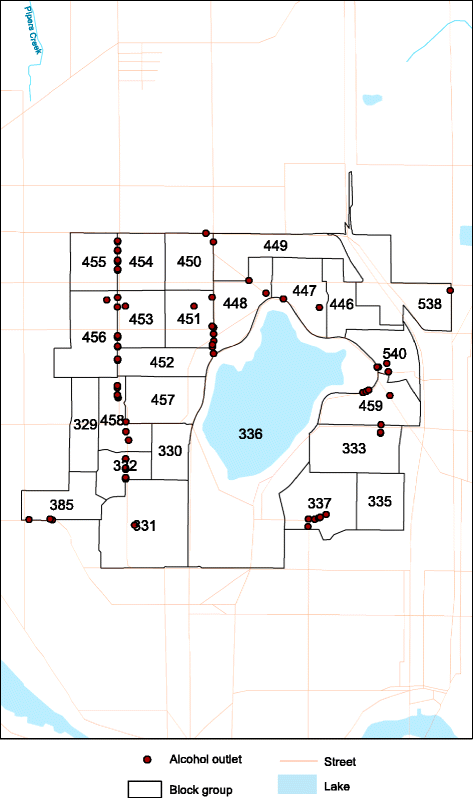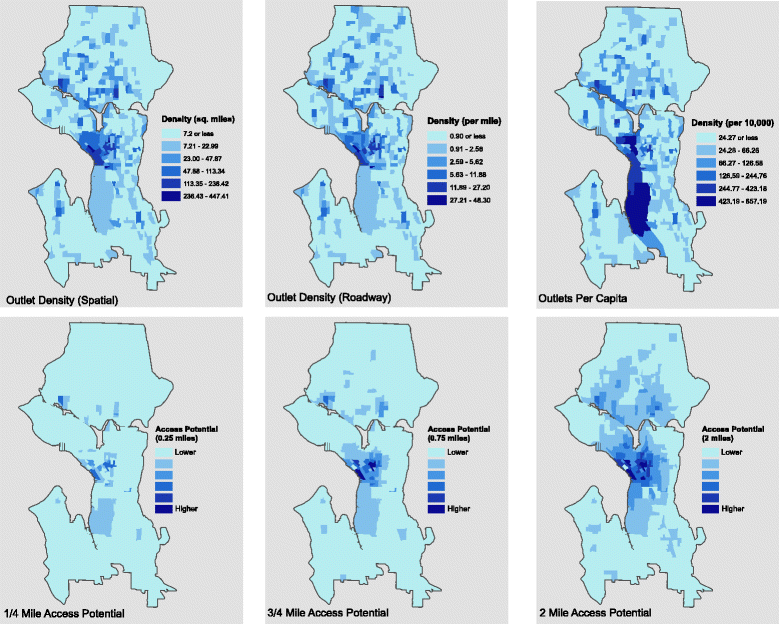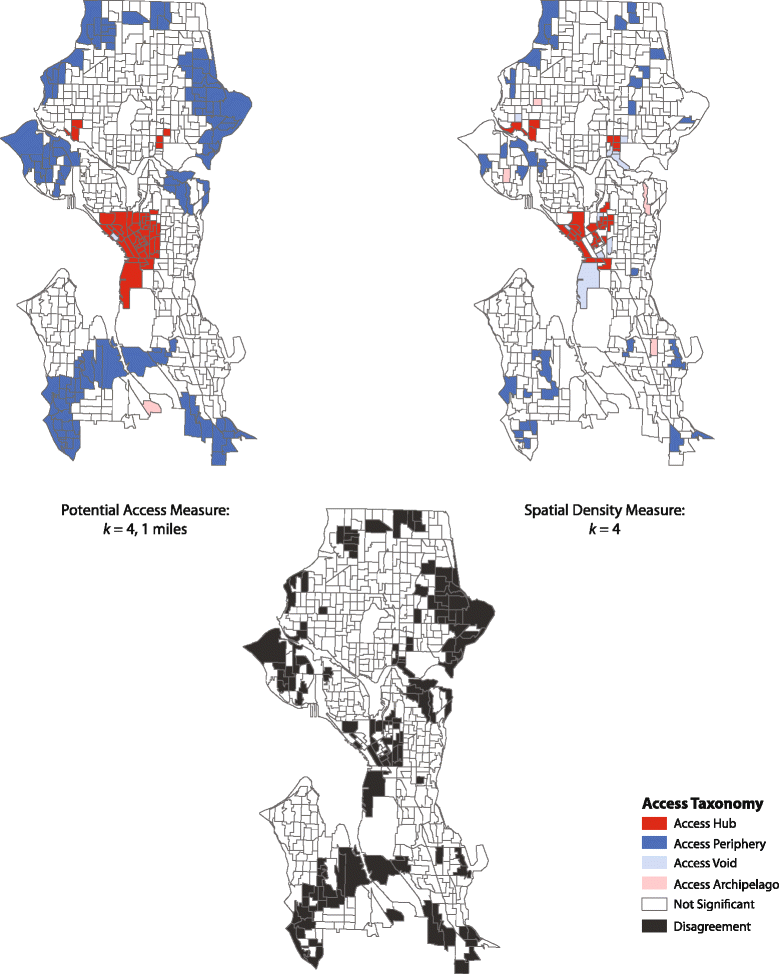Comparative approaches for assessing access to alcohol outlets: exploring the utility of a gravity potential approach
- PMID: 27486385
- PMCID: PMC4969650
- DOI: 10.1186/s12963-016-0097-x
Comparative approaches for assessing access to alcohol outlets: exploring the utility of a gravity potential approach
Abstract
Background: A growing body of research recommends controlling alcohol availability to reduce harm. Various common approaches, however, provide dramatically different pictures of the physical availability of alcohol. This limits our understanding of the distribution of alcohol access, the causes and consequences of this distribution, and how best to reduce harm. The aim of this study is to introduce both a gravity potential measure of access to alcohol outlets, comparing its strengths and weaknesses to other popular approaches, and an empirically-derived taxonomy of neighborhoods based on the type of alcohol access they exhibit.
Methods: We obtained geospatial data on Seattle, including the location of 2402 alcohol outlets, United States Census Bureau estimates on 567 block groups, and a comprehensive street network. We used exploratory spatial data analysis and employed a measure of inter-rater agreement to capture differences in our taxonomy of alcohol availability measures.
Results: Significant statistical and spatial variability exists between measures of alcohol access, and these differences have meaningful practical implications. In particular, standard measures of outlet density (e.g., spatial, per capita, roadway miles) can lead to biased estimates of physical availability that over-emphasize the influence of the control variables. Employing a gravity potential approach provides a more balanced, geographically-sensitive measure of access to alcohol outlets.
Conclusions: Accurately measuring the physical availability of alcohol is critical for understanding the causes and consequences of its distribution and for developing effective evidence-based policy to manage the alcohol outlet licensing process. A gravity potential model provides a superior measure of alcohol access, and the alcohol access-based taxonomy a helpful evidence-based heuristic for scholars and local policymakers.
Figures






Similar articles
-
Changes in density of on-premises alcohol outlets and impact on violent crime, Atlanta, Georgia, 1997-2007.Prev Chronic Dis. 2015 May 28;12:E84. doi: 10.5888/pcd12.140317. Prev Chronic Dis. 2015. PMID: 26020548 Free PMC article.
-
Access to alcohol outlets and harmful alcohol consumption: a multi-level study in Melbourne, Australia.Addiction. 2011 Oct;106(10):1772-9. doi: 10.1111/j.1360-0443.2011.03510.x. Epub 2011 Jul 28. Addiction. 2011. PMID: 21615583
-
Quantifying spatial accessibility in public health practice and research: an application to on-premise alcohol outlets, United States, 2013.Int J Health Geogr. 2018 Jun 27;17(1):23. doi: 10.1186/s12942-018-0143-y. Int J Health Geogr. 2018. PMID: 29945619 Free PMC article.
-
Measuring Alcohol Outlet Density: An Overview of Strategies for Public Health Practitioners.J Public Health Manag Pract. 2020 Sep/Oct;26(5):481-488. doi: 10.1097/PHH.0000000000001023. J Public Health Manag Pract. 2020. PMID: 32732722 Free PMC article. Review.
-
Changing the density of alcohol outlets to reduce alcohol-related problems.Drug Alcohol Rev. 2007 Sep;26(5):557-66. doi: 10.1080/09595230701499191. Drug Alcohol Rev. 2007. PMID: 17701520 Review.
Cited by
-
Looking Back and Moving Forward: The Evolution and Potential Opportunities for the Future of Alcohol Outlet Density Measurement.Addict Res Theory. 2021;29(2):117-128. doi: 10.1080/16066359.2020.1751128. Epub 2020 May 6. Addict Res Theory. 2021. PMID: 33883975 Free PMC article.
-
Outlet Type, Access to Alcohol, and Violent Crime.Alcohol Clin Exp Res. 2018 Nov;42(11):2234-2245. doi: 10.1111/acer.13880. Epub 2018 Sep 26. Alcohol Clin Exp Res. 2018. PMID: 30256427 Free PMC article.
-
Does Tobacco Outlet Inequality Extend to High-White Mid-Atlantic Jurisdictions? A Study of Socioeconomic Status and Density.J Racial Ethn Health Disparities. 2019 Apr;6(2):409-418. doi: 10.1007/s40615-018-00538-9. Epub 2018 Nov 16. J Racial Ethn Health Disparities. 2019. PMID: 30446987 Free PMC article.
-
Methods for Evaluating the Association Between Alcohol Outlet Density and Violent Crime.Alcohol Clin Exp Res. 2019 Aug;43(8):1714-1726. doi: 10.1111/acer.14119. Epub 2019 Jun 24. Alcohol Clin Exp Res. 2019. PMID: 31157919 Free PMC article.
-
Is proximity to alcohol outlets associated with alcohol consumption and alcohol-related harm in Denmark?Nordisk Alkohol Nark. 2018 Apr;35(2):118-130. doi: 10.1177/1455072518759829. Epub 2018 Feb 23. Nordisk Alkohol Nark. 2018. PMID: 32934521 Free PMC article.
References
-
- Block RL, Block CR. Space, place and crime: hot spot areas and hot places of liquor related crime. Crime Prevention Studies. 1995;4:145–83.
-
- Roman CG, Reid SE, Bhati AS, Tereschenko B. Alcohol outlets as attractors of violence and disorder. The Urban Institute. 2008. http://www.urban.org/publications/411663.html. Accessed 27 Apr 2015.
-
- Britt HR, Carlin BP, Toomey TL, Wagenaar AC. Neighborhood level spatial analysis of the relationship between alcohol outlet density and criminal violence. Environ Ecol Stat. 2005;12:411–26. doi: 10.1007/s10651-005-1518-3. - DOI
Publication types
MeSH terms
Substances
LinkOut - more resources
Full Text Sources
Other Literature Sources
Medical

